Today I’m going to show you my version of guksu (국수), a simple and delicious noodle soup, and one of my all-time favorites and go-to regular meals. This version is spicy and savory. I always have kimchi and anchovies on hand, so it’s something that I can always make quickly for lunch, or when people suddenly come over.
Guksu is also a special-occasion dish because Koreans traditionally associate long thin noodles with longevity, so we often serve it at birthday parties, to wish for a long life, and at weddings, to wish for a long marriage.
I learned this version from a friend of mine in Korea who came from Gyeongsang province, at a time when I lived in Jeolla province. It’s different than the traditional way of making it, which is the version I show in my cookbook. That way uses anchovy or beef stock with hot pepper flakes and chopped green onions as a garnish. To make it look fancy, sauteed zucchini, marinated and cooked beef strips, and a pan-fried egg stips (gyeran-jidan) can be added over top.
This version uses a kimchi mixture for a spicy kick, and uses my special anchovy stock. The stock is something I’ve been developing for years. Dried anchovies, kelp, radish, and onion give plenty of flavor and umami and a bit of sweetness, which makes it a good base for many other dishes, too. And when the mix of kimchi, green onions, honey, toasted sesame oil, and hot pepper paste meets that savory stock, it creates a unique, unforgettable flavor.
I made 10 cups of anchovy stock in this recipe, enough for a couple bowls of guksu with leftovers you can freeze or keep in the fridge for up to 4 days. Then you can add the stock to stews, soup, or just like me, use it to make a yummy steamed eggs in an earthenware pot (ttukbaegi-gyeranjjim).
I hope you enjoy this recipe as much as I do. Just writing this, I feel like having a bowl of guksu!
Ingredients (for 2 servings)
- 10 ounces somyeon (thin wheat flour noodles)
- 1 tablespoon toasted sesame seeds, ground
- 1 sheet of gim (seaweed paper), toasted, crushed in a plastic bag to make seaweed flakes (gimgaru: 김가루)
- 2 poached eggs (optional)
For the anchovy stock (makes 10 cups’ worth):
- 14 cups of water
- 8 ounces Korean radish or daikon, sliced thinly
- 4 green onions
- 1 medium onions (about 7 ounces), sliced
- 18-20 large dried anchovies, heads and guts are removed
- 1 ounce dried kelp
- 2½ teaspoons salt
For the spicy kimchi mix:
- 4 green onions, chopped
- 4 ounces of chopped fermented kimchi (about ½ to 2/3 cup)
- 2 tablespoons hot pepper paste
- 1 teaspoon honey
- 2 teaspoons toasted sesame oil
Directions
The best way to make guksu is to prepare the stock and kimchi mixture first, and then make the noodles rapidly and put the guksu together just before serving. This way, the noodles don’t have time to sit and be soggy. They should be fresh and snappy when served, and the guksu should be served hot and quickly slurped.
Make the stock:
- Combine the water, radish, and onion, green onion roots, anchovies, and kelp in a large saucepan, cover, and cook over medium-high heat for 30 minutes.
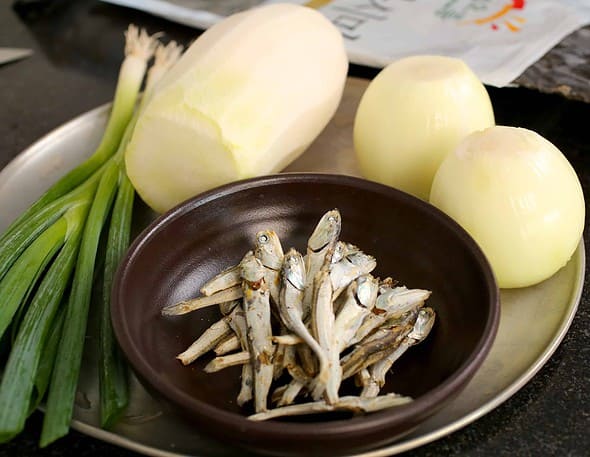

- Turn down the heat to low and boil another 20 minutes.
- Turn off the heat and strain. You will get about 10 cups of stock. Stir in the salt.
Make the spicy kimchi mix:
Cook the noodles:
- Bring a large pot of water to a boil. Add the noodles and stir them with a wooden spoon so that they don’t stick together.
- Cover and cook over medium heat for 3-4 minutes until they start boiling over.
- Open, lower the heat to low, and stir. Cook another minute until the noodles are nicely cooked. Take a sample: it should be chewy but there shouldn’t be anything hard in it as you chew.
- Strain and rinse the noodles in cold water a couple of times. Strain them. Divide the noodles into 2 portions and put each portion into a serving bowl or pot.
Make guksu:
- I like to warm the noodles up first, because they’ve been rinsed in cold water and they will cool down the soup. Use a strainer and a ladle to put a bit of bubbling hot stock over the noodles, and then drain it back out into the stockpot so it can be heated again. Do this a couple of times until the noodles are heated up.
- Add 2 or 2½ cups of the hot stock to the noodles. Place the kimchi mixture, ground sesame seeds, and gimgaru (crushed seaweed flakes) in the center of the noodle soup.

- Add a poached egg on top if you made one.
- Serve hot and eat immediately.

Maangchi's Amazon picks for this recipe
It's always best to buy Korean items at your local Korean grocery store, but I know that's not always possible so I chose these products on Amazon that are good quality. See more about how these items were chosen.



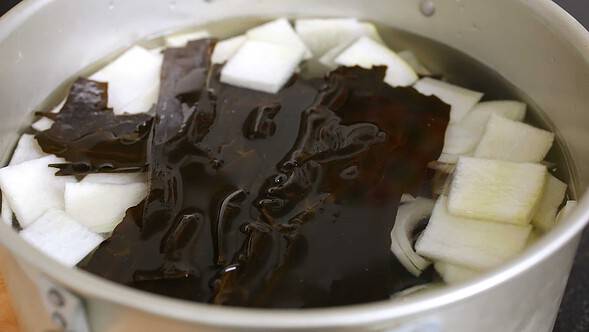
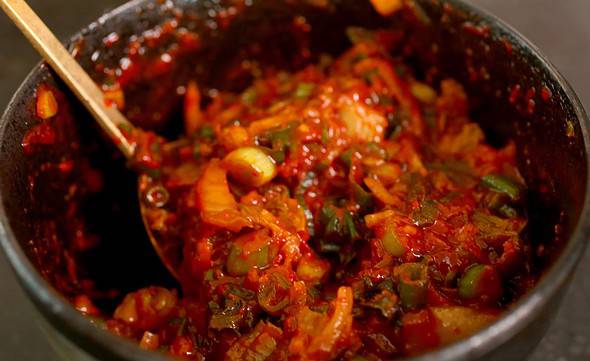
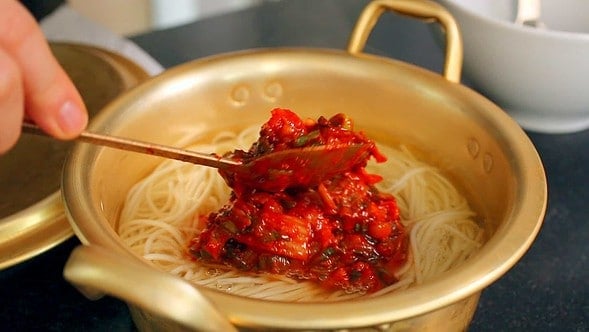
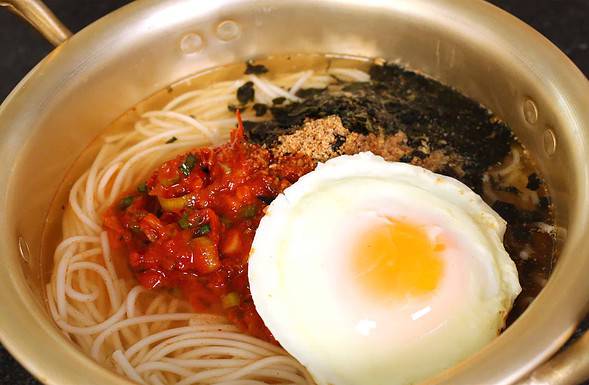




![[NongHyup] Dried Korean Seawee...](https://m.media-amazon.com/images/I/41snm3pr68L._SL160_.jpg)





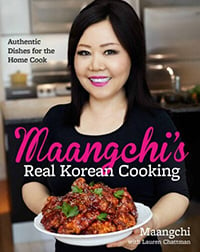
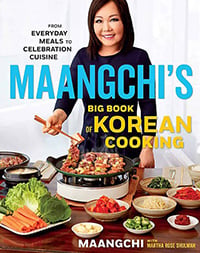




















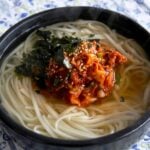
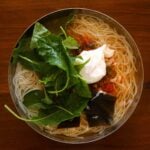

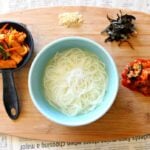
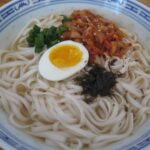
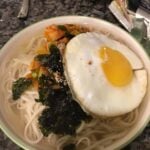
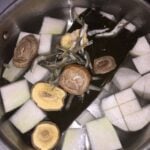
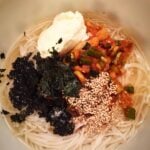
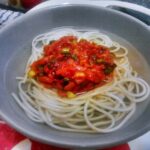
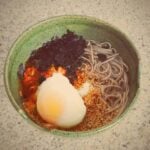
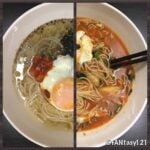
Made janchi-guksu (korean banquet noodle soup) at home…yum..
See full size image
It’s a great idea to add mushroom! Delicious!
OK! instead of dried fish, dashida took anchovy soup
See full size image
Nice!
Yum, this was delicious. Thanks!
See full size image
Your noodles are well-cooked so they will be chewy but cooked. The presentation is great and the egg hat looks stunning. I love the photo!
Guksu is my night savior!
Coming home laaaate at night, time to bed but hungry and craving for good homemade food ? No problem for me thanks to this recipe!
In that context, i admit that i make the lazy version… industrial chicken stock and dehydrated noodles, simply pourring a raw egg at the end… but still delicious recipe :) the kimchi mixture makes the dish! A good kimchi means delicius meals!
ok, now i’ going to sleep, well fed and a smile on my face ;)
Wonderful korean noodle soup! We veganized the recipe and cooked it without fish and egg :-)
See full size image
This exactly looks like my noodle soup! Did you use vegetable stock?
Thank you! We love korean food expression :-) Yes, we use vegan stock with korean or japanese kelp (dasima/kombu) and shiitake mushrooms
Hi Maangchi! I’m really interested in making this recipe for a dinner party, but I know that my guests have a sensitivity to gluten. Are there gluten-free versions of the somyeon noodles? Or is there a good substitute you would recommend? Thank you! <3
Hi Maangchi, I made this and it tastes fantastic. I forgot to buy ghim but the broth is such a huge hit. Will continue to make more of your recipes!
See full size image
umm~ I’m making it for lunch today! Irresistible! : )
Hi Maangchi, I love love this recipe. I really love poached egg too, and overtime I try poaching like you do in the video, only the edges cook and the middle of the egg is still raw. Is the stock at too low of a temperature for it to cook completely? How high should the stock be cooking while I cook the egg in the ladle? Thank you!
Hi Maangchi! Can I replace gim with nori, it’s really hard to find gim here And if I use nori, should I toast it, or better not?
Gim is nori in Japanese.
Hi Maangchi! This soup looks absolutely amazing. Actually all of your recipes do. I was thinking about serving this at a dinner party. If I wanted to serve 6-8 peopke, can I simply triple the recipe you have or would you recommend something else? Thank you for sharing your knowledge of Korean dishes!
Hi Maangchi,
I love your recipes! I have been buying a lot of kitchenware as I am moving. I purchased a lot of korean earthenware and I LOVE it, but my question is what cutting board are you using? I could not find it anywhere. Thank you.
I have several cutting boards but 4 of them (thick ones) are from Brooklyn Butcher Blocks.
Maangchi, when you put the anchovy stock in the freezer, do you separate into 1-cup portions? What is easiest in your opinion? I imagine it would be difficult to use to make another soup if it is one big, frozen block. Or do you thaw the entire portion, take what you need, and re-freeze leftovers? Does it cause it to degrade (thaw, freeze)…?
I would like to make this stock to keep in the freezer and save time when cooking during the weekdays. You can use it for so many delicious dishes! :-)
Thanks again!
I put all the leftover anchovy stock in a container and freeze it. When I need it, put it in a pot and boil it and use. If I still have some left over anchovy stock, I keep it in the fridge. It will be ok in the fridge for a couple of days. Good luck with your anchovy stock!
WOW!! Maangchi that guksu really look delicious, comforting and warming!! and i just looove your tiny little pot!! is that korean pot?? i just saw your video and i can’t wait to go to the asian grocery shop, grab the ingredients and make it!!
Did you get it yet? https://www.maangchi.com/kitchenware/tin-pot
HI, Maangchi! How can I replace the anchovies? Can I use fish sauce? In the local Korean grocery store is not dried anchovies :(
If dried anchovies are not available, you could use any of your favorite stocks such as beef, chicken, or vegetable stock.
Hi Maangchi!
Very interesting recipe for me. I was born and lived many years in Uzbekistan, where, as You know, as i remember, there were many Koreans (“Koryo Saram”), that was deported into Middle Asia in the time of WWII.
Guksu (or “Kuksu” in the russificated adoptation of the word) is very populuar dish both among the Uzbekistan’s koreans and other peoples living in that land.
Nevertheless, this dish differs from the recipe You kindly offer us.
In our version – obviously, adopted under local conditions – guksu is a “cold summer soup”, like spanish “gaspaccho”, russian “okroshka” or uzbekish “chalop”.
It consists from three parts:
1. Soup base (named “kuksi-muri”) – chilled water with addition of soybean souce, sodium glutamate, vinegar and sugar.
2. Thin noodles.
3. A lot of salads and other add-ons: fried beef with cabbage, fresh cucumbers, tomatoes, green onion, thin egg pancakes etc.
Thank you for sharing the information about Uzbekistan kuksu. Actually it’s my favorite. I often visit my favorite Uzbekistan restaurant in Brighton Beach to eat their cold noodle soup.
Check out my blog posts.You will enjoy reading them. https://www.maangchi.com/blog/korean-uzbek-meetup
https://www.maangchi.com/blog/korean-uzbek-cuisine
Oh, thank You for reply! That are all very well-known since my childhood scents :-)
There is a whole district in Uzbekistan capital, Tashkent, where live many ethnical Koreans, named “Kuylyuk”, where You can find a lot of such little restaurants.
I was very lucky to find one of such restaurant here, at north of the Russia, in St. Petersburg.
Of course, i make some dishes myself for my family from time to time, too.
Thank You for Your blog!
Perhaps, it could be interesting for You: in Tashkent lives well-known in russian blogosphere dame, Lilia Nikolenko, which is much more experienced in the cuisine of Uzbekistan Koreans than me. That is her site: http://www.azu.uz. She writes in Russian, but speaks English freely, so You can communicate with her in English.
Wow! What a great story! Thank you for telling it!
Thank you for all the information which is great! If I visit Tashkent someday, I will check out Kuylyuk area as soon as possible! Of course I will read the blog you recommend.
Looks so good! I think I’m going to make it soon!
Mmm. A place near me does a really good janchi guksu filled with yummy veggies.
Might have to try this now that I know how to do the anchovy broth.
Hi! Could you tell me what the name of the restaurant you were referring to is called? I was wondering because I live near Northern VA.
I just watched the video.
Now I’m hungry! ;-)
Bye, Sanne.
Thanks a lot Maangchi. Cannot wait to make! I love noodles and this stock seems so easy and delicious! Thanks for all the effort you put into making these videos! Really appreciated!!